In this post, we discuss namarupa. Like the Five Aggregates, namarupa suggests that rupa is not what it seems to be.
Namarupa (Chinese=名色), according to The Princeton Dictionary of Buddhism, is “in Sanskrit, “name-and-form,” “mind-and-matter,” “mentality-and-materiality;” a term for the mental and physical constituents of the person; with “name” subsuming the four mental aggregates, ….and form (rupa) referring to the material aggregate.”
This definition of namarupa is consistent with what The Princeton Dictionary of Buddhism defines the Five Aggregates, “Of these five, only rupa is material, the remaining four involve mentality and are collectively called “name” (nama), thus the compound “name-and-form,” or “mentality-and-materiality” (namarupa).”
However, these definitions of namarupa and the Five Aggregates are inconsistent with Buddha’s teaching on reality. Distinguishing materiality from mentality as separate entities is what Buddha calls the delusional misunderstanding of reality.
If, indeed, materiality and mentality were different entities, there would be no need for Buddhism because there would be no delusional misunderstanding of reality. Without delusion, there would be no suffering resulting from it. Consequently, there is no need for Buddha’s soteriological mission to help people understand their delusions and thus liberate them from suffering.
Therefore, correctly understanding Namarupa and the Five Aggregates is crucial in Buddhism.
First, let’s examine how namarupa originated in the Twelvefold Chain of Dependent Origination doctrine.
Dependent origination is known in Romanized Sanskrit as pratityasamutpada.
Pratityasamutpada (Chinese=緣起), according to The Princeton Dictionary of Buddhism, is “in Sanskrit, “dependent origination,” “conditioned origination,” lit. “origination by dependence” (of one thing on another): one of the core teachings in the Buddhist doctrinal system, having both ontological, epistemological, and soteriological implications.” Furthermore, “in one of the earliest summaries of the Buddha’s teachings (which is said to have been enough to bring Sariputra to enlightenment), the Buddha is said to have taught:” “When this is present, that comes to be. /From the arising of this, that arises. / When this is absent, that does not come to be. / From the cessation of this, that ceases.”
Buddha enumerates twelve interconnected links in the life cycle of beings, hence the name Twelvefold Chain of Dependent Origination. Namarupa appears as the fourth link.
The first seven links are listed below to help explain namarupa, which appears as the fourth link.
1) Non-luminosity
2) Samskara (Chinese=行)
3) Vijnana (Chinese=識)
4) Namarupa (Chinese=名色)
5) Sadayatana (Chinese=六入)
6) Ayatana (Chinese=觸)
7) Vedana (Chinese=受)
1) Non-luminosity (Chinese=無明). As discussed previously, non-luminosity (Chinese=無明) belongs to Such is the Way of Dharma and, therefore, is “not causal.” It is, therefore, the only entity that can be the first link in the Twelvefold Chain of Dependent Origination because all other phenomena in its domain are causally originated.
The subsequent two links, Samskara and Vijna, are the fourth and fifth Aggregates, respectively.
Given that all beings are dependently originated, and the Five Aggregates are the constituents of beings, it makes sense that the Five Aggregates and the Twelvefold Chain of Dependent should intersect.
But, if they do intersect, why are the first and second aggregates missing when originating from non-luminosity? The reason is that origination starting from non-luminosity is a special case because it is the only case when origination begins without materiality.

As mentioned previously, Dr. Tong’s image shows ripples in the fluctuating quantum energy field. In Buddhism, these ripples are fluctuations in non-luminosity. While they appear as ripples, ripples are forms without materiality. They still qualify as rupa because the definition of rupa includes “body, form, and materiality.”
As fluctuating mentality, ripples are conscious. Since they are without material sensor faculties, the Aggregate of Sensing or Receiving is unnecessary. The ripples can sense each other directly because the fluctuating mental field connects them. Indeed, ripples can observe each other, as Buddha teaches in the Three Delicate Marks.
A similar reasoning applies to why the third Aggregate is missing. As fluctuations in the mental field, the ripples are already active mentality and can conceptualize without becoming the “reading-in of the mind.”
Again, as Buddha teaches in the Three Delicate Marks, ripples can conceptualize an “external realm” without any material sensory faculties.
2) Samskara (Chinese=行). The second link, samskara, is the same as the third Aggregate, or the Aggregate of conceptualization. The Aggregate of Conceptualization is needed because conceptualizing the incoming “experiential content” is necessarily an individual event, given that it changes with every fluctuation.
3) Vijna (Chinese=識). The third link, Vijna, is the same as the Aggregate of Consciousness. The Aggregate of Consciousness must be present because, like the link preceding it, projections of conceptualized images are necessarily individual events since the images change with every fluctuation also.
4) The fourth link, Namarupa (Chinese=名色), is the subject of our discussion.
However, before discussing how to understand namarupa in detail, let’s first move on to the three links following namarupa to validate the reasoning why the second and third aggregates are missing earlier.
5) Sadayatana (Chinese=六入). The fifth link, Sadayatana, according to The Princeton Dictionary Buddhism, refers to “the six internal sense-bases.”
6) Ayatana (Chinese=觸). The sixth link, Ayatana, according to The Princeton Dictionary Buddhism, is “sensory contact.“
7) Vedana (Chinese=受). The seventh link, Vedana, is the same as the first Aggregate of the Five Aggregates, the Aggregate of Sensing or Receiving.
In other words, with the appearance of namarupa, the six internal sense-bases formed. With the formation of the six sense bases, the incoming “content” must first make “sensory contact” with them. With sensory contact made, the “content” of “how the world impacts us” can be received.
By skipping the second and the third aggregates earlier, Buddha indeed says they are only needed once materiality appears.
So, what is a namarupa?
As the first entity to have rupa, namarupa corresponds to Buddha’s “microscopic dust where rupa gathers.” Furthermore, as discussed earlier, the “microscopic dust where rupa gathers” corresponds to the Higgs Boson in science. Higgs Boson is often deemed God particle because the scientific universe cannot be built without it. It is the same in Buddhism. Without namarupa, the Twelvefold Chain of Dependent Origination cannot continue, and no material phenomena can appear.
So, how should we understand namarupa? Did Buddha really teach that “name” subsumes “the four mental aggregates?” Are “mentality-and-materiality” two distinctly different entities?
Buddha’s answer to these questions can be found in his teaching on the Four Realms of Reality.
In his teaching on the Four Realms of Reality, the word that subsumes all mentality is “principle,” not name. The origin of its use can be traced to Citta’s role as the First Principle of Truth. However, “principle” applies to mentality in general, fluctuating or not, which is why Buddha uses “principle” to refer to mentality in teaching the Four Realms of Reality.
Buddha’s teaching on the meaning of “mentality-and-materiality” can be found in “The dharmadhatu of the unobstructed interpenetration between principle and phenomena (Chinese=理事無礙法界), the third of the Four Realms of Reality.
As was written then, “In science, the “dharmadhatu of the unobstructed interpenetration between principle and phenomena” is called wave-particle duality, also known as the central mystery of quantum mechanics, which says that “everything in the universe, from light to electrons to atoms, behaves like both a particle and wave at the same time. Wave-particle duality is not only true with the ripples in the quantum realm, but it also applies to galaxies in the sky, as the image from Dr. Tony Tyson shows.”
Simply stated, wave-particle duality means particles and waves coexist on the same phenomenon. Wave-particle duality applies to all phenomena, from the ripples in the quantum realm to galaxies in the sky, as can be seen in the image from Dr. Tony Tyson.

In Buddhism, wave-particle duality means mentality and particles coexist on the same phenomenon. Of the two, mentality is the essence because particles are just mentality waving. Everything in the world deemed material is just mentality waving. In nature, there is nothing but mentality. Whether a phenomenon appears or not depends on whether mentality fluctuates.
In other words, “name-and-form” should be interpreted as “form in name only, i.e., nominally rupa. This interpretation applies to all “body, form, and materiality,” which represents all phenomena in the world. In other words, while all phenomena look like “body, form, or materiality,” they are only nominally “body, form, and materiality.” The essence of all phenomena is mental.
It is what Buddha teaches in Mohe Zhiguan, “Mentality is the nature of existence of all rupa.” It is also what the Five Aggregates educate. Namarupa is no different.


